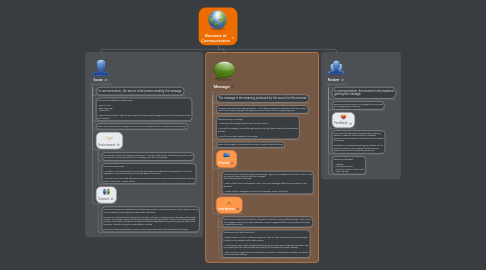
1. Source
1.1. In communication, the source is the person sending the message.
1.2. The source conveys this message using: - Tone of Voice - Body Language - Appearance In good communication, both the source and the receiver send messages to each other, through channels and feedback.
1.3. Before the source sends a message to the receiver, it's important for them to take note of two things:
1.4. Environment
1.4.1. Environment is where the message is being sent. The room, table, chairs, and lighting all make up the environment, and have an effect on the message and how it is presented.
1.4.2. Factors of Environment: - Formality: Is the environment formal or informal? It would be awkward for the speaker to use formal language in a very casual setting, and equally awkward vice versa - Proximity: How close is the other person to me? People tend to communicate intimately when they are close to each other, or when texting.
1.5. Context
1.5.1. Context is the scene and expectations of the people involved. When people communicate, they are coming from somewhere and bringing their expectations with them. Environment is dependent on context; how formal, or informal, an environment is depends on the people involved. One teacher may be used to being treated formally, and another may be used to being treated casually. Both people are teachers, but each has different expectations they are bringing with them in the classroom; therefore they both create different contexts. Context is all about expectations; good communication takes note of the context of the situation.
2. Message
2.1. The message is the meaning produced by the source for the receiver.
2.2. Message is more than just organized words; it's not what you say that's important, but how you say it. Tone of voice, body language, and appearance are all a part of the message being sent.
2.3. Steps to sending a message: 1. Determine the message; what to say and how to say it? 2. Encode the message; choose the right words in the right order to perfectly communicate the idea. 3. Send the encoded message to the receiver.
2.4. Before the message is received by the receiver, it goes through two things:
2.5. Channel
2.5.1. The channel is the method to get across message. When a source speaks or writes to a receiver, they are using a channel to get across their message. There are two types of channels: - Spoken: face to face conversations, radio, voice mail messages, telephone conversations, and speeches - Written: letters, newspapers, invoices, text messages, emails, and blogs
2.6. Interference
2.6.1. Interference is anything that blocks or changes the intended meaning of the message. Most, but not all, messages usually go through interference; research suggests that we only comprehend 25-50% of everything we hear.
2.6.2. Interference could take three forms: - Physical Noise: Car horns, cellphone ringtones, radio, or other conversations can interrupt your thoughts or conversation with another person. - Psychological Noise: Other thoughts that preoccupy you while you're listening to someone else may prevent you from listening attentively enough to understand the whole message. - Other sources: Hunger, tiredness, temperature, and other uncomfortable conditions can distract and interfere with listening.
